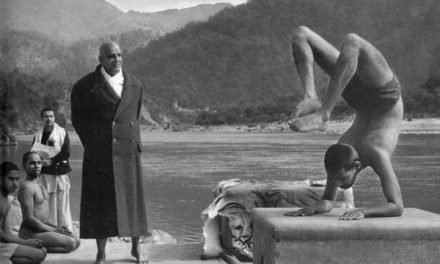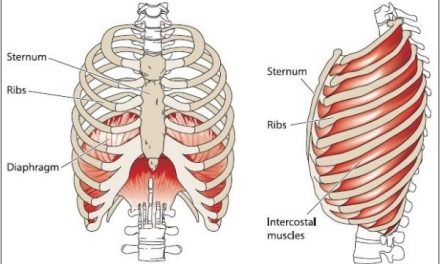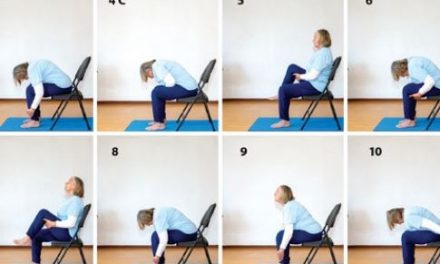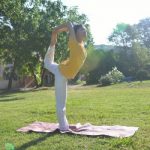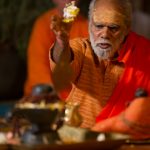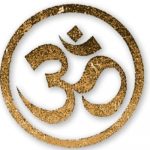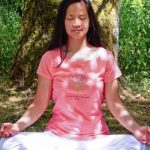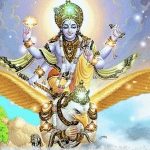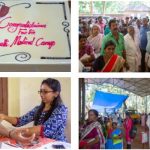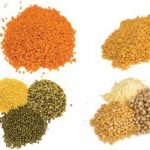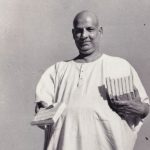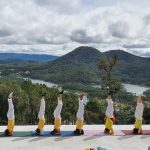Thoughts on Hatha Yoga
Teachings from Swami Vishnudevananda
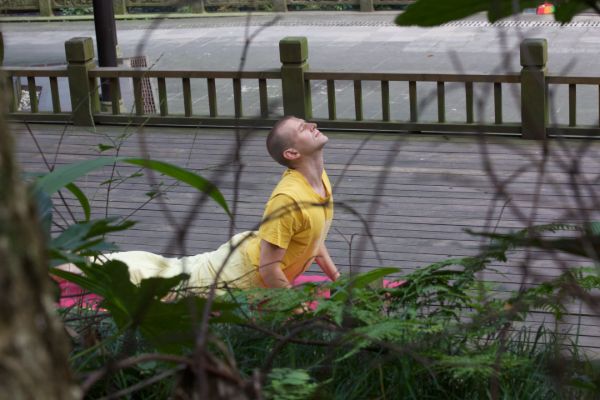 Hatha Yoga as ladder to Raja Yoga
Hatha Yoga as ladder to Raja Yoga
In raja yoga, sadhana is mostly internal, the restraint of mental modifications. In mantra yoga, japa and worship are stressed. In laya yoga, the sadhaka shuts out all external sounds, concentrates on the anahata nada and dissolves his mind in it. Hatha yoga enables you to awaken the latent kundalini shakti by the practice of asanas and pranayama. When this shakti, that lies dormant in the muladhara chakra at the base of the spine, attains union with Siva in the sahasrara padma at the crown of the head, the yogi attains swarupa jnana or atma-jnana, knowledge of the Self.
For an external observer, hatha yoga appears to be an entirely physical process. Many people nowadays do asanas and pranayama merely for maintaining good health and correcting certain defects of the functioning of the body. No doubt, hatha yoga enables you to maintain perfect health. And, in this respect hatha yoga is infinitely superior to all tonics and medicines; for it enables you to tap the infinite source of vital power lying latent within you.
Various asanas, mudras, bandhas and pranayamas are prescribed by the hatha yoga scriptures for this purpose. When the kundalini reaches the sahasrara chakra, She attains union with the Lord residing there; the sadhaka experiences cosmic consciousness and is liberated from samsara. As hatha yoga concerns itself with the human body, vital breath and the subtle nerves, the practitioner derives the incidental advantages of health and mental efficiency from the practice.
Hatha Yoga as a Spiritual Practice
Hatha yoga is a spiritual practice which ranks on a par with vedantic meditation, the practice of the highest form of devotion to God, or egoless service of the Lord in all, karma yoga. This is the most essential point I would pray to you all to bear in mind. Hatha yoga is the most scientific method of controlling the mind. Mind has its vibrant power in the prana, and it flows out through the various organs.
Hatha yoga restrains the prana; automatically the activities of the mind are curbed. The organs of perception, jnana indriyas, and action, karma indriyas, are animated by prana; their play also is restricted by pranayama. Thus you get perfect control of body and mind through the practice of asanas and pranayama very easily. Practice hatha yoga. Within a very short time, you will know its benefits.
You will enjoy a peace of mind and an inward bliss that you cannot get from any external source. You will have great control over emotions. Lust, anger, jealousy, and other baser passions will vanish. You will have greater willpower. You will become a super-being who will be loved, respected and honoured by all.
Integral Yoga Practice
Gurudev Sivananda emphasised again and again that hatha yoga should invariably form part of the integral sadhana of every aspirant. Many people ignore asanas and pranayama as a mere set of physical feats unnecessary for yoga sadhana, and sometimes a hindrance, too. This is because they have not yet understood the link between the gross and subtle.
You all know that vedanta teaches that there are five koshas, sheaths, enveloping the Self: annamaya, pranamaya, manomaya, vijnanamaya and anandamaya koshas. Each kosha interpenetrates the other. Annamaya is gross; pranamaya is subtler, manomaya is still more subtle. In a subtle manner pranamaya kosha interpenetrates the annamaya kosha. Each cell of the body vibrates with prana. In the body there are 72,000 nadis or pranic electric wires that carry this pranic current to every individual cell of the body.
Now, you can visualise that even if you forget this gross physical body, you have within you its complete double in the shape of this electric pranic body. Similarly in the case of manomaya kosha, which interpenetrates this pranamaya kosha. Now you will understand how a gross practice as asana and the external breath control help one in effecting the requisite inner transformation in the mind and in the subtler aspects of the personality. Asanas automatically exercise the subtle nadis within. Pranayama exercises a direct influence over these nadis and ensures the rhythmic, powerful vibration of prana through all the nadis.
Deeper Inner Sadhana
Only now is the aspirant ready for the deeper inner sadhana of pratyahara, dharana and dhyana, that leads him to samadhi. When the nadis are impure and clogged here and there: when the prana vibrates inharmoniously through them, the mind will either be dull, tamasic or restless, rajasic. The greater time and attention the aspirant devotes to the initial preliminaries, the quicker and surer he will attain siddhi, powers in his higher yoga practices.
Yama-niyama should therefore receive our greatest attention. They are the foundations to the whole edifice of yoga. They are the first two steps in raja yoga. If one is established in yama (ahimsa, satyam, brahmacharya, asteya and aparigraha) and in the practice of niyama (saucha, santosha, tapas, swadhyaya and ishwarapranidhana), then and only then will it be possible for one to make any progress in yoga at all. After come asana and pranayama as the third and fourth limbs of the external raja yoga but which, you can well understand, have a tremendous influence on the internal personality of the person.
Then comes the purely internal practice of pratyahara—or the withdrawal of the senses from their outgoing tendencies. The sadhaka is dead to the world, but very much alive within himself. Then dharana when he fixes his mind on the lakshya within, on the Lord within, on his own Self. Dhyana, which naturally follows automatically, leads to samadhi by long, continued practice.
Prana in the Sushumna
Even in these higher, inner yoga practices, hatha yogins believe that it is through the long continued practice of pranayama when the prana enters the sushumna that the aspirant gets pratyahara, and a prolongation of this state is termed by them as dharana, dhyana and samadhi. The prana that has entered the sushumna, and which is totally prevented from flowing out, does not stand still, but rapidly progresses along the sushumna, taking the kundalini shakti from chakra to chakra till She attains union with Siva in the sahasrara when the yogi enjoys the bliss of samadhi.
That is the ultimate aim of hatha yoga. The asanas and pranayama have that blissful samadhi as their goal. Forget not this fact. They are essentially spiritual practices. That they ensure your physical and mental well-being, that they free you from diseases, weakness and inertia, that they impart lustre to your whole body and invigorate the entire system is an added glory to the yogic system, but their goal is something very much higher.
Asanas and pranayama are part of yoga sadhana. They can confer their spiritual benefits upon you only if they are based on the foundations of yama-niyama, a strong character; and if they get the help of auxiliaries like diet, and a pure sattvic daily life. Otherwise they will be merely physical exercises. Of course, you will enjoy good health and freedom from disease, but of what use is health and strength, if the mind within is rotting, and the canker of evil is eating into your very vitals?
I would emphasise here that the practice of asanas and pranayama tends to conserve the prana, makes the prana flow in, and harmonises our entire system. As it eradicates tamas and rajas, sattva grows in you. Supplement this by taking a sattvic diet, by leading a sattvic life. Do not take any food or drink that agitates the nerves. You will then experience a marvellous change in your mind. You will ever be calm, peaceful and blissful.
True it is that the practice of asanas and pranayama, combined with the intake of sattvic diet automatically gives you a sattvic mind, shuts out all impure thoughts and desires and promotes sublime thoughts and aspirations in your mind. But, in the beginning stages, when this effect has been fully achieved, you should make positive efforts, too, to achieve this result. How can you fill a pot, even if you pour millions of gallons into it, if there is a big hole in its bottom?
Importance of Brahmacharya
Brahmacharya is an all-important factor. It is one of the five great yamas in raja yoga. Nowadays people suffer from all sorts of diseases and weaknesses, only because in their youth they did not observe brahmacharya. You are all young, healthy and radiant. If you observe brahmacharya, you will remain youthful, healthy and radiant throughout your life.
Asanas and pranayama purify the pranamaya kosha or life principle, which stands as a link between the gross physical body and the mind. So, you can readily understand that if you want to derive the maximum benefit from their practice, you should keep the mind pure on the one hand, and lead a harmonious outward life so that the body may be able to receive and profit by the abundant inflow of pranic energy. The reward is great and worth the little discipline that we impose upon ourselves.
There are certain precautions, which any serious practitioner of pranayama should take before launching forth on this attempt to control the most powerful force of prana. One of the fundamental pre-requisites is sattvic food. Only when nutritious and pure food is taken will pranayama bestow its glorious fruits upon the sadhaka. Any quiet, cool and secluded place, with pure and holy surroundings is the best place for practice of pranayama.
At such a place, seat yourself in padma or siddha asana, over a seat of kusa grass and cloth placed one over the other. Understand that prana is the extremely subtle element that pervades the atmosphere and that enters you through the food you eat, through the water you drink, and most important of all, the air you breathe. It is not the breath, but the subtle vitality in the breath. In practising pranayama, you are trying to get mastery over the subtle principle. This is impossible except through the grace of Lord and the Guru. Therefore, as soon as you sit for pranayama, offer prayers. Pray for spiritual illumination. Calm the mind. Commence pranayama.
Connection of the Breath and Prana
Even after a very little practice you will realise that the breath and the prana are very closely connected. When your mind is pure, when your thoughts are holy and sublime, the flow of breath is scarcely perceptible. When the mind is agitated, the breath is disturbed, violent and hard. Therefore, acquire purity of mind first. Practice yama-niyama. Be virtuous and pure in thought, word and deed. Then pranayama will lead to dhyana and samadhi.
During the first few months, practice only breathing in through the left nostril and breathing out through the right, and then breathing in through the right, breathing out through the left. This is called nadi-shuddhi, cleansing of psychic passages. When the breathing becomes steady, rhythmic and calm, you can start sukha-purvak pranayama with kumbhak. When you attain perfection in this you can adopt the ratio of 1: 4: 2 for purak, inhalation, kumbhak, retention and rechak, exhalation.
What asanas and pranayama initiate, mudras and bandhas ensure. Asanas stabilise the body and enable pranayama to proceed smoothly. Through pranayama the sadhaka tries to unite the prana and the apana. Mudras seal this union of prana-apana so that the union might not be disturbed. Bandhas tie this marvellous effect.
Union of Prana & Apana
When the prana and apana are thus held in union, a great mysterious and powerful spiritual current is generated within, which cannot be described in words and which has to be experienced by each sadhaka. This power pierces the entrance to the sushumna. Pratyahara supervenes. Then, the kundalini shakti is awakened and taken from chakra to chakra, and the sadhaka enjoys dharana, dhyana and samadhi.
Whilst Yoga asanas and even pranayama to a certain degree can be practiced by all without any elaborate preliminaries, it is advisable that a serious practice of pranayama by a whole-time sadhaka should be preceded by preliminary purificatory practices called kriyas. Kriyas cleanse the internal organs. This you can very easily see when they are demonstrated. Neti cleanses the nasal passages. Dhauti cleanses the alimentary canal up to the stomach. Bhasti cleanses the lower intestines. Nauli enables you to acquire perfect cleanliness of all the abdominal viscera. Tratak helps in concentration, and purifies the nadis of the eyes. Kapalabhati cleanses the brain.
Through the practice of yoga asanas and pranayama you can conquer old age. Sirshasana ensures the health of eyes, ears and the brain; even the hairs draw plentiful nourishment from this king of all asanas. It helps you in observing brahmacharya, which in turn gives you lustrous countenance and lustrous eyes. The spine will be elastic and healthy if you are regular with paschimotthanasan and halasan and ardha matsyendrasan.
Digestion will be good and you will have strong, healthy teeth. You will have astounding nerve-power and at 80 you will be able to think faster and deeper than a youth of 18. It would not be wise to confine the fruits of Yoga to the warding off of diseases and the conquest of old age. We should never, never forget that asanas and pranayama are the stages along our evolution to the great goal—God-realisation.

